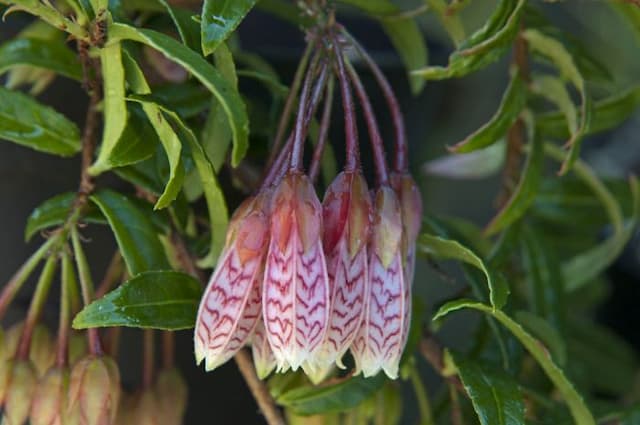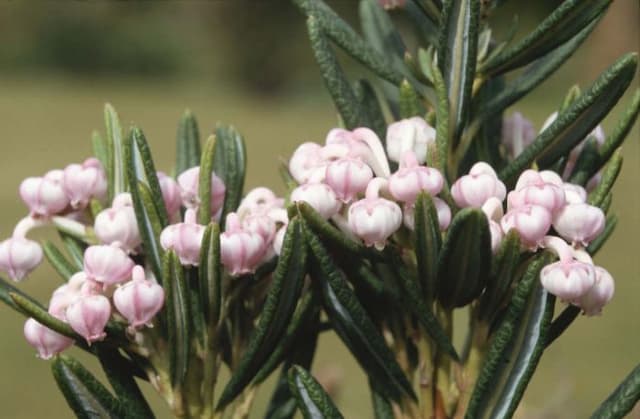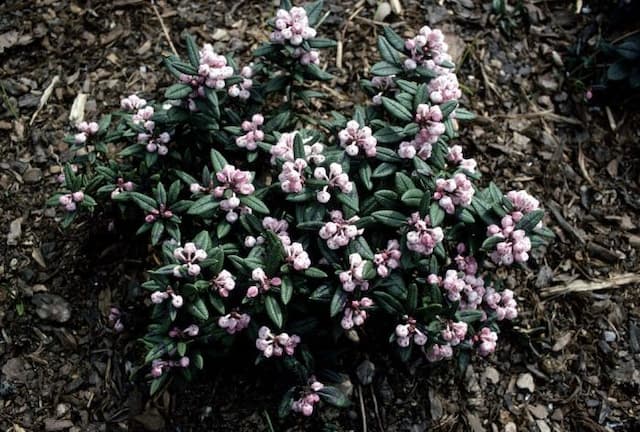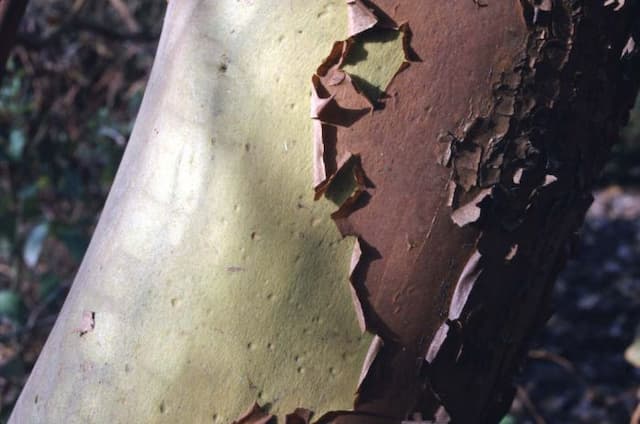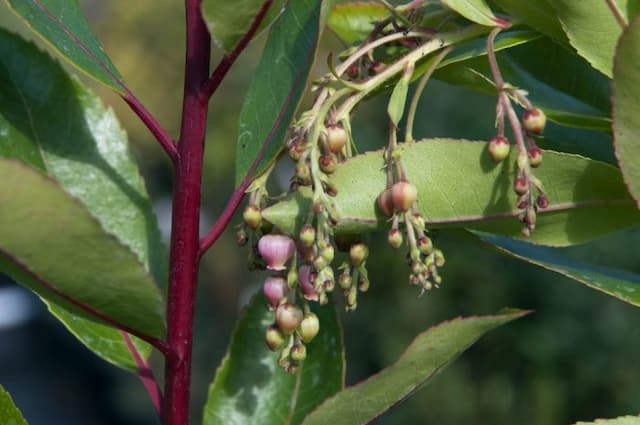Darley Dale Heath Erica × darleyensis 'J.w. Porter'

ABOUT
Erica × darleyensis 'J.W. Porter', commonly known as winter heath, presents with an evergreen habit, showcasing a dense covering of needle-like foliage which remains vibrant throughout the year. The leaves are small and narrow, typically dark green in hue, offering a fine-textured appearance. The winter heath blooms with an abundance of bell-shaped flowers, usually in shades ranging from pale pink to deep magenta. These tiny flowers cluster along the branches and provide a striking contrast against the dark foliage, creating a visually appealing display. The vibrant flowering period occurs during the colder months, bringing color to the garden when many other plants are dormant. The overall impression given by the winter heath is one of a lush, colorful, evergreen shrub that adds life and interest to the landscape during a time of year when it is much needed.
About this plant
 Names
NamesFamily
Ericaceae
Synonyms
Darley Dale Heath, Winter Heath, Darley Heath, Mediterranean Pink Heath
Common names
Erica × darleyensis 'J.W. Porter'
 Toxicity
ToxicityTo humans
Darley Dale heath is generally considered non-toxic to humans. There are no significant toxicity reports regarding ingestion of this plant by humans. Therefore, it is not commonly associated with any poisoning symptoms or adverse health consequences when touched or ingested in small quantities.
To pets
Darley Dale heath is not known to be toxic to pets. It is generally considered safe around animals, and there is no widespread documentation of poisoning or adverse symptoms as a result of pets ingesting this plant. However, as with any non-food plant, ingestion of large amounts may cause gastrointestinal upset due to the irritation of the stomach or intestines.
 Characteristics
CharacteristicsLife cycle
Perennials
Foliage type
Evergreen
Color of leaves
Green
Flower color
Pink
Height
2 feet (0.61 meters)
Spread
3 feet (0.91 meters)
Plant type
Shrub
Hardiness zones
7
Native area
Europe
Benefits
 General Benefits
General Benefits- Year-round interest - Erica × darleyensis 'J.W. Porter', commonly known as Darley Dale heath, provides garden interest throughout the year with its evergreen foliage and long-lasting flowers.
- Attracts wildlife - The blooms attract pollinators like bees and butterflies, benefiting the local ecosystem.
- Drought tolerance - Once established, Darley Dale heath is relatively drought-resistant, requiring less water and maintenance.
- Low maintenance - It requires minimal pruning and care, making it an excellent choice for gardens where low maintenance is a priority.
- Soil adaptability - This plant can survive in a range of soil types, although it prefers well-drained, acidic soils.
- Cold hardiness - It can withstand cold temperatures, making it suitable for gardens in cooler climates.
- Versatile landscaping - It can be used in a variety of garden settings, including rock gardens, borders, ground cover, or as container plants.
- Color variety - The flowers provide vibrant color in shades ranging from white to pink to deep red, depending on the variety.
- Erosion control - Its dense mat-forming habit can help stabilize soil and prevent erosion on slopes.
 Medical Properties
Medical PropertiesThis plant is not used for medical purposes.
 Air-purifying Qualities
Air-purifying QualitiesThis plant is not specifically known for air purifying qualities.
 Other Uses
Other Uses- Dye Production: The leaves and flowers of the Winter Heath can sometimes be used to create natural dyes for textiles, offering a range of colors depending on the mordant used.
- Insect Habitat: Offering shelter to beneficial insects, this plant can be used in insectaries to promote biological control of pests.
- Photography: With its vibrant colors, Winter Heath is often used as a subject in botanical and garden photography.
- Floral Arrangements: Its long-lasting flowers and foliage make it suitable for use in cut floral arrangements.
- Educational Tool: This hybrid's characteristics can serve to illustrate plant hybridization and inheritance in academic settings.
- Artistic Inspiration: Artists may use the striking appearance of Winter Heath as inspiration in painting, drawing, and other visual arts.
- Craft Projects: Dried branches and flowers can be utilized in making wreaths, potpourri, and other craft items.
- Fairy Gardens: The small-scale and dense foliage make it a popular choice for creating whimsical fairy garden landscapes.
- Ecological Studies: Winter Heath can serve as a model organism in studies of plant ecology and adaptation to harsh climates.
- Winter Gardens: Utilized in winter garden displays, it adds color and life during the coldest months of the year.
Interesting Facts
 Feng Shui
Feng ShuiThe Winter Heath is not used in Feng Shui practice.
 Zodiac Sign Compitability
Zodiac Sign CompitabilityThe Winter Heath is not used in astrology practice.
 Plant Symbolism
Plant Symbolism- Endurance: Erica × darleyensis, commonly known as winter heath, often blooms in the coldest months, symbolizing the ability to endure and thrive even in harsh conditions.
- Protection: The evergreen nature of winter heath implies constancy and protection throughout the year, as it remains vibrant even when other plants have died back.
- Solitude: As a plant that can thrive in rocky and barren landscapes, winter heath signifies a stoic independence and contentment in solitude.
- Good Luck: In some traditions, heathers like winter heath are considered to bring good luck, particularly when planted near the home.
- New Beginnings: Blooming in the winter months, winter heath can represent the idea of new beginnings or starting afresh, as it brings color to the garden when most other plants lie dormant.
 Water
WaterThe most common common name for Erica × darleyensis 'J.W. Porter' is Darley Dale heath. When watering Darley Dale heath, it is important to keep the soil consistently moist, especially during the first growing season to establish a deep, extensive root system. Once established, they are more drought tolerant. In general, water the plant deeply, providing about 1 to 2 gallons per week, depending on the weather conditions. During hot or dry periods, you may need to water twice a week, and less frequently during cooler, rainy spells. Be cautious not to overwater, as this can lead to root rot.
 Light
LightDarley Dale heath thrives best in full sun to partial shade. It is ideal to plant it in a spot that receives at least four to six hours of direct sunlight each day. If the heath is planted in an area with too much shade, it may not bloom as prolifically. During the hottest parts of the day, some light shade can be beneficial, particularly in warmer climates.
 Temperature
TemperatureDarley Dale heath is hardy and can tolerate a wide range of temperatures, but it prefers cooler conditions. It can generally survive temperatures as low as 10 degrees Fahrenheit and as high as 75 degrees Fahrenheit. The ideal temperature range for optimal growth is between 40 and 65 degrees Fahrenheit. This plant is accustomed to the climate of its heathland origins and does well in the temperature range typical of these areas.
 Pruning
PruningPruning Darley Dale heath is beneficial for maintaining its shape and promoting denser growth. The best time for pruning is immediately after flowering, typically in late spring. Lightly trim the plant to remove spent flowers and to shape the plant; this will encourage new growth. Pruning should be done annually to prevent the plant from becoming leggy.
 Cleaning
CleaningAs needed
 Soil
SoilDarley Heath thrives in acidic, well-draining soil with a pH between 4.5 and 5.5. A mix of peat, sand, and loamy soil is ideal, ensuring proper drainage and aeration while retaining adequate moisture.
 Repotting
RepottingDarley Heath typically requires repotting every 2 to 3 years. It is best done in the spring before new growth starts to allow the plant to establish in its new container.
 Humidity & Misting
Humidity & MistingDarley Heath prefers moderate to high humidity levels but is adaptable to lower humidity environments common in home settings.
 Suitable locations
Suitable locationsIndoor
Place in bright, indirect light with acidic soil for indoor Darley Heath growing.
Outdoor
Plant in partially shaded area with acidic, well-draining soil for outdoor Darley Heath.
Hardiness zone
5-8 USDA
 Life cycle
Life cycleErica × darleyensis 'J.W. Porter', commonly known as Darley Dale heath, begins its life cycle when seeds from the mature plant are dispersed and germinate, typically in well-drained, acidic soil. The seedlings quickly develop a root system and sprout their first juvenile foliage, which is often needle-like and dense. As the plant enters the vegetative stage, it grows rapidly and begins to form the characteristic woody stems and evergreen leaves of mature heaths, with some plants also producing offshoots that can develop into new plants. Flower bud initiation occurs in response to environmental cues, leading to a prolific bloom of pink to white flowers that usually appear in winter to spring, attracting pollinators. After pollination, seed capsules develop and ripen, eventually opening to release seeds and complete the reproductive cycle. Once the plant has reached the end of its lifespan, which can be several years, it will die back and decompose, providing nutrients back to the soil and potentially leaving behind seeds to start the next generation.
 Propogation
PropogationPropogation time
Spring to early summer
Erica × darleyensis 'J.W. Porter', commonly known as Darley Dale heath, is typically propagated by semi-ripe cuttings. The optimal time for taking these cuttings is during the late summer, when the new growth has started to harden but is not fully woody. To propagate, a 2- to 4-inch cutting is taken from a healthy parent plant, making sure the cutting has no flower buds. The leaves at the lower third of the stem are removed, and the cut end is dipped in rooting hormone to encourage root development. The cutting is then placed in a well-draining potting mix, ensuring that the leafless part of the stem is buried. The pot should be kept in a warm, humid environment, with indirect sunlight until roots have developed, which can be checked by gently tugging on the cutting after a few weeks to assess resistance.
